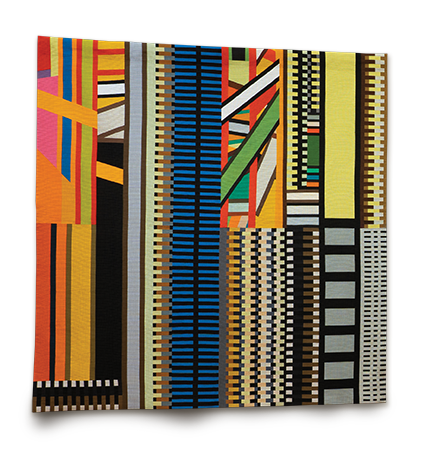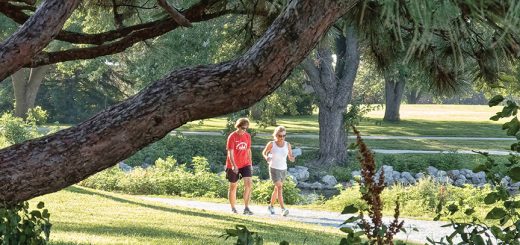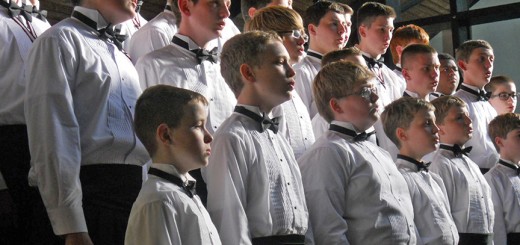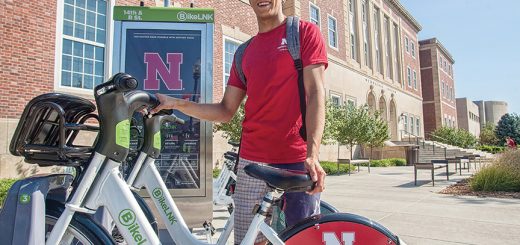The International Quilt Museum

by Laura Chapman
Nestled on the University of Nebraska-Lincoln’s East Campus, the International Quilt Museum is home to the world’s largest publicly held quilt collection. With rotating exhibitions pulling from that collection as well as other major collections and artists from around the world, the IQM provides a glimpse into folk art through the ages and from around the world.
In 2021, the IQM will celebrate the 50th anniversary of the seminal exhibition Abstract Design in American Quilts. The exhibition displayed historical quilts from the Jonathan Holstein and Gail Van der Hoof Collection with a focus on design and artistry at the Whitney Museum of Art in New York City in 1971, before traveling to Japan.
In addition to showing pieces from the original exhibition—which are now part of the IQM’s permanent collection—the installation will also feature three supporting exhibits inspired by it.
“In the whole series we wanted to bring the exhibition forward and show how it made an impact on the last half century,” said Marin Hanson, IQM curator of international collections. “We’re really helping to talk about the influence of ‘Abstract Design in American Quilts’ over time and across the globe.”
The first exhibition will be a reinstallation of the majority of the 1971 Whitney quilts, curated by IQM Curator of Collections Carolyn Ducey, with input from the original collector and curator, Jonathan Holstein. These quilts are now part of the museum’s permanent collection.
The second exhibit will be guest curated by independent scholar Sandra Sider. It will examine the impact of the Whitney show on the larger worlds of studio craft, fine art and design.
The third related exhibit will feature quilts that reflect the Whitney show’s influence on the U.S. DIY movement and quilt revival of the 1970s and beyond, curated by IQM Assistant Curator of Exhibitions Jonathan Gregory.
The fourth and final exhibition will focus on the influence this selection of quilts had on Japan. Curated by IQM Curator of International Collections Marin Hanson and Saitama University professor Nao Nomura, this exhibit will display works commissioned from some of Japan’s premiere artist. Each quilt has been made in the artist’s signature style in response to a quilt from the original show.
“We wanted to include an exhibition about the collection in Japan because it shows the global impact the exhibition had,” said Marin Hanson, IQM curator of international collections. “It’s our first time commissioning a body of work.”
These works also illustrate the museum’s multi-year commitment to build a robust collection of Japanese quilts.
Located on the corner of 33rd and Holdrege streets in Lincoln, Nebraska, the IQM is open Tuesdays through Saturdays from 10 a.m. to 4 p.m. Tickets are available for purchase upon arrival with a sliding scale of rates. The museum is a proud partner of Museums for All, which offers free or reduced admission for those receiving food assistance, and Blue Star Museums, which offers active military service members and their families free admission between Memorial Day and Labor Day.
When visiting the museum Tuesday-Friday, guests can view quilt care in action through the observation windows outside the Byron and Sara Rhodes Dillow Conservation Work Room, located on the first floor. There, IQM collections team members and volunteers vacuum and accession quilts in addition to refolding the entire collection every two years. At any given time, a variety of quilts might be out on the tables for care.
Also on the first floor, visitors will find the Pumphrey Family Gallery, which showcases works from some of today’s leading and emerging quilt artists and makers.
Take the Grand Staircase up to the second floor to view curated exhibitions in the museum’s main galleries: the Coryell Gallery, the Gottsch Gallery, the Von Seggern Gallery and the West Gallery. Visitors will also find quilts from the IQM’s education collection or community works on display in the Beavers Terrace Gallery. These galleries rotate exhibitions two or three times a year, highlighting a wide variety of quilts, including historical, international, modern and art.
On the museum’s third floor, view more quilts from the museum’s Education Collection and visit the Ghormley Reading Room. There, the museum’s youngest visitors will find a variety of activities and quilt-related books to read.
Before leaving, visit the gift shop. It offers a wide-range of gifts ranging from local hand-crafted items to fabric, sewing notions and more.
Guests can also enjoy the museum’s architecture and garden, which were both designed with quilts in mind. The International Quilt Museum was designed by the internationally renowned Robert A.M. Stern Architects of New York with local architects Alley, Poyner, Macchietto Architects of Omaha.
The architects intended the structure to resemble the three layers of a quilt. The glass curtain wall—with its linear metal bars—resemble quilt stitches. The galleries, conservation workroom and storage room represent the batting or filling. The back-of-house support areas and offices represent the quilt back. The museum’s reception hall is shaped like the eye of a needle. And the brick facade and relief around the building are done to look like quilt blocks.
The International Quilt Museum’s Marion E. and Barbara B. Tritsch Garden was designed in a grid to resemble quilt blocks stitched together. It is planted and maintained by the University of Nebraska-Lincoln’s Landscape Services team using native Nebraskan plants. Some of the plants are annuals and the others are perennials that are replanted seasonally. Plants include Blue Shag White Pine, Green Velvet Boxwood, Purple Cornflower, Blue False Indigo and more.














Recent Comments